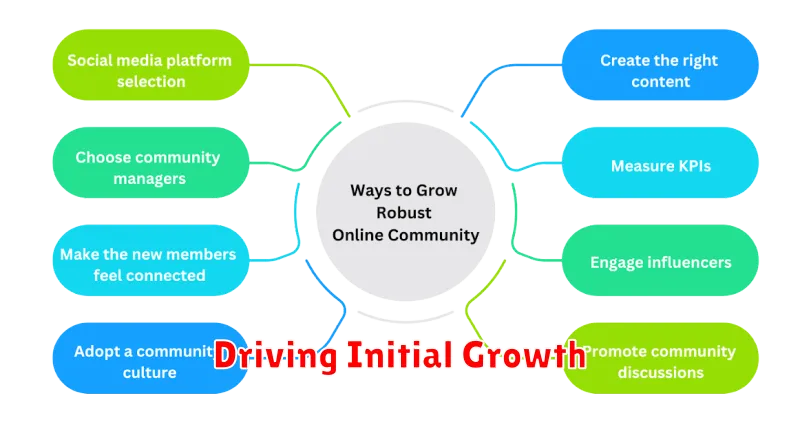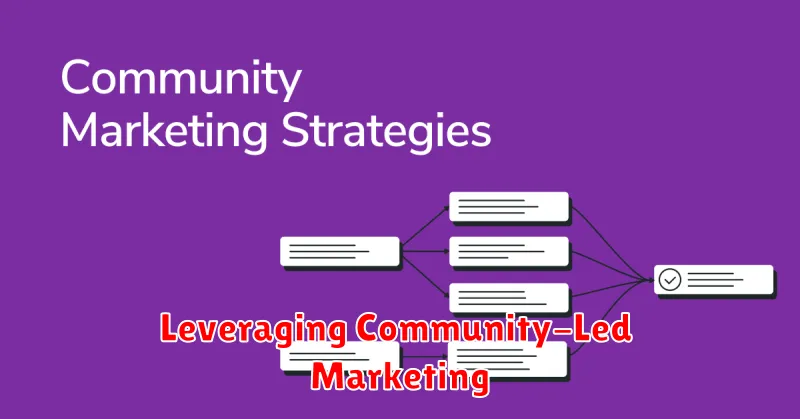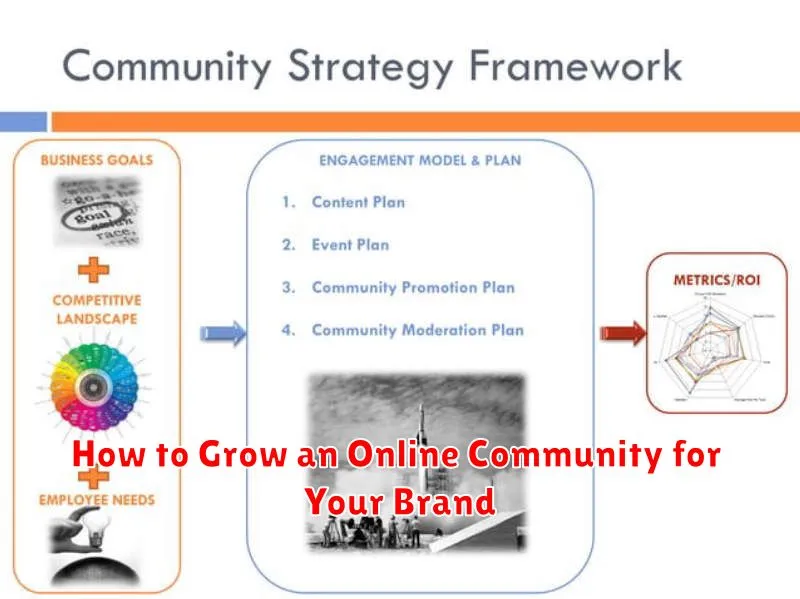Building a thriving online community is no longer a luxury, but a necessity for brands seeking to cultivate meaningful connections with their audience. In today’s digital landscape, a strong online community can significantly impact brand loyalty, customer engagement, and ultimately, business growth. This guide explores the essential steps to grow an online community specifically for your brand, offering practical strategies to build an engaged and loyal following that actively contributes to your brand’s success. Learn how to leverage the power of community building to foster a sense of belonging, drive brand advocacy, and transform casual customers into passionate brand ambassadors.
Whether you’re starting from scratch or looking to revitalize an existing online presence, this article will equip you with the knowledge and tools you need to effectively grow an online community for your brand. We’ll delve into identifying your target audience, selecting the right platform, creating compelling content, fostering meaningful interactions, and measuring your community’s growth. By understanding the core principles of online community building and implementing these practical strategies, you can create a vibrant online hub where your brand and its audience can connect, collaborate, and thrive together. This will not only enhance your brand reputation but also provide invaluable insights into your customers’ needs and preferences, allowing you to tailor your offerings and strengthen your brand identity within the digital space.
Why Community Building Is Essential
Community building is crucial for fostering a sense of belonging, shared identity, and collective action. It creates a supportive environment where individuals feel connected, valued, and empowered to contribute. This sense of connection strengthens social bonds, promotes collaboration, and facilitates the sharing of resources, knowledge, and support. Ultimately, strong communities are more resilient, adaptable, and better equipped to address challenges and achieve common goals.
For organizations, community building translates to increased engagement, loyalty, and advocacy. By fostering a sense of community among customers or members, organizations can cultivate deeper relationships, generate valuable feedback, and inspire word-of-mouth marketing. Internally, strong communities within an organization can improve communication, boost morale, and enhance productivity.
The benefits of community building extend beyond individual and organizational levels, contributing to broader societal well-being. Strong communities contribute to greater social capital, increased civic participation, and reduced social isolation. They offer a platform for addressing social issues, promoting inclusivity, and building a stronger, more cohesive society.
Choosing the Right Platform

Selecting the right platform for your project is a critical first step. The ideal platform depends on a number of factors including project requirements, budget, technical expertise, and scalability needs. Careful consideration of these elements will ensure the chosen platform effectively supports development, deployment, and ongoing maintenance.
Key factors to consider include the programming languages supported, available integrations with other systems, and the platform’s overall security posture. Additionally, understanding the platform’s community and available support resources can significantly impact long-term success. A thorough evaluation process is essential for making an informed decision.
Finally, remember to factor in the total cost of ownership. This includes not only the initial platform cost but also ongoing maintenance, licensing fees, and potential training expenses. By carefully weighing these factors, you can choose the platform that best aligns with your project’s needs and sets the stage for successful execution.
Creating Valuable Engagement Spaces
Creating valuable engagement spaces requires a strategic approach focused on fostering meaningful interactions. This involves carefully considering the target audience and tailoring the environment, whether physical or digital, to meet their specific needs and interests. Key elements include providing opportunities for collaboration, networking, and knowledge sharing. The space should be designed to encourage active participation and facilitate open communication, ultimately fostering a sense of community and belonging.
A crucial aspect of creating a valuable engagement space is ensuring accessibility and inclusivity. This means considering factors such as physical accessibility for individuals with disabilities, as well as providing diverse formats and channels for participation to accommodate different learning styles and preferences. Providing clear guidelines and expectations for behavior within the space is also important to create a safe and respectful environment that encourages open dialogue and discourages harmful or discriminatory behavior.
Ultimately, the success of an engagement space is measured by the value it provides to its participants. This value can take many forms, including increased knowledge, new connections, and a sense of empowerment. Regular evaluation and feedback are essential for continuous improvement, ensuring that the space remains relevant and responsive to the evolving needs of the community it serves.
Establishing Rules and Culture
Establishing a strong and positive organizational culture begins with clearly defined rules and expectations. These rules should not just be a list of prohibitions, but rather a framework that guides behavior and promotes desired values. Transparency and consistency are key in implementing these rules. Ensure all members of the organization understand the rationale behind them and that they are applied fairly across the board. This fosters a sense of fairness and accountability, crucial for building trust and respect.
Beyond the formal rules, fostering a positive culture requires actively shaping the shared values, beliefs, and behaviors within the organization. This can be achieved through open communication, collaboration, and recognizing and rewarding positive contributions. Leaders should embody the desired culture and actively promote it through their actions and decisions. Creating opportunities for social interaction and team building can also strengthen relationships and build a sense of community.
Regularly evaluating and adapting the rules and cultural initiatives is essential for maintaining their effectiveness. Soliciting feedback from all levels of the organization can provide valuable insights into what’s working well and what needs improvement. This iterative approach ensures that the rules and culture remain relevant and supportive of the organization’s overall goals and evolving needs.
Driving Initial Growth

Driving initial growth for a new product or business requires a focused strategy and efficient execution. Key areas to concentrate on include identifying your target audience, crafting a compelling value proposition, and selecting the right marketing channels to reach potential customers. Early traction is crucial for securing future funding, attracting talent, and building momentum.
Tactics for achieving initial growth can vary depending on the industry and specific offering. However, some common approaches include leveraging social media marketing, implementing targeted advertising campaigns, building strategic partnerships, and offering promotional incentives to early adopters. Gathering and analyzing data is essential to understand what resonates with your target audience and refine your strategies accordingly.
Sustaining initial growth requires a commitment to continuous improvement. Regularly analyze your key metrics, gather customer feedback, and be prepared to adapt your approach as needed. Building a strong team and fostering a culture of innovation are vital for long-term success. Remember, early growth is a stepping stone towards establishing a sustainable and thriving business.
Content That Encourages Interaction
Interaction is key to a thriving online community. Engaging content sparks conversation and fosters a sense of belonging. Think about asking questions, running polls, or hosting Q&A sessions to encourage your audience to participate.
High-quality content is essential for drawing people in. This means providing valuable information, offering unique perspectives, and presenting it in a clear and concise manner. Focus on creating content that is relevant to your audience and addresses their needs and interests.
Creating a welcoming environment is crucial. Encourage positive interactions and respond thoughtfully to comments and questions. Make sure everyone feels comfortable sharing their thoughts and opinions. This will build trust and loyalty within your community.
Leveraging Community-Led Marketing

Community-led marketing empowers brands to build authentic relationships with their customers. By fostering a sense of belonging and encouraging customer advocacy, brands can tap into the power of organic growth. This approach prioritizes genuine interaction and values customer contributions, creating a loyal and engaged community that drives both brand awareness and sales. It moves away from traditional, top-down marketing strategies and focuses on building a strong, self-sustaining ecosystem where customers become brand ambassadors.
A key benefit of community-led marketing is the ability to generate user-generated content. This content, created by customers, is seen as more trustworthy and relatable than traditional marketing materials. It can take many forms, including reviews, testimonials, social media posts, and even blog articles. This organic content helps build credibility and reach new audiences within the existing customer base’s networks, driving organic growth and reducing reliance on paid advertising.
Successfully implementing a community-led approach requires active listening and consistent engagement. Brands need to provide platforms and opportunities for customers to connect with each other and the brand itself. This can include online forums, social media groups, and even in-person events. By actively participating in these communities, brands can build trust, gather valuable feedback, and identify key influencers who can further amplify their message. It’s about creating a two-way dialogue, not just broadcasting information.
Recognizing and Rewarding Contributors
Recognizing and rewarding contributors is crucial for maintaining morale and motivation. It shows appreciation for their hard work and dedication, encouraging continued high performance. Methods for recognition can range from simple verbal praise to more formal awards, while rewards can include bonuses, promotions, or other incentives. Choosing the right approach depends on the specific contribution, the individual’s preferences, and the overall company culture.
Effective recognition should be timely and specific. Highlighting the particular achievement and its positive impact reinforces the desired behavior. Public acknowledgement, when appropriate, can further amplify the impact of the recognition. For example, mentioning a successful project completion during a team meeting or featuring an employee’s contribution in a company newsletter can boost their sense of accomplishment.
A well-structured rewards system should be fair and consistent. Clearly defined criteria for rewards ensure transparency and avoid perceptions of favoritism. Regularly reviewing and updating the system helps ensure it remains aligned with company goals and values. This helps maintain a motivated and productive workforce, driving continued success.
Handling Conflict and Moderation
Conflict is a natural part of online communities. Effective moderation is crucial to maintain a healthy and productive environment. Moderators should be impartial and enforce community guidelines consistently. Their primary goal is to facilitate constructive dialogue and prevent disruptive behavior, such as harassment, hate speech, and spamming. By addressing conflicts swiftly and fairly, moderators protect the community and encourage positive interactions.
When handling conflict, moderators should prioritize de-escalation. This might involve reminding participants of the community guidelines, issuing warnings, or temporarily muting disruptive users. Transparency is also important. Moderators should clearly communicate the reasons for their actions to both the involved parties and the wider community. This helps build trust and reinforces the importance of following the established rules.
Prevention is always better than cure. Clear and concise community guidelines are essential. These guidelines should outline acceptable behavior, the consequences of violations, and the process for reporting issues. A well-defined reporting system empowers community members to take an active role in maintaining a positive environment. Regularly reviewing and updating the guidelines based on community feedback further strengthens the framework for conflict resolution.
Tracking Community Health Metrics
Tracking community health metrics is crucial for understanding the overall well-being of a population and identifying areas for improvement. These metrics provide valuable insights into the prevalence of diseases, health behaviors, access to healthcare, and the effectiveness of public health interventions. By monitoring these indicators, public health officials can make informed decisions about resource allocation, program development, and policy implementation to address community health needs effectively.
Key metrics often tracked include life expectancy, infant mortality rates, rates of chronic diseases (such as diabetes and heart disease), prevalence of substance abuse, access to preventive care (like vaccinations), and self-reported health status. Data for these metrics can be gathered through various sources, including vital records, surveys, hospital discharge data, and public health surveillance systems. Analyzing trends in these metrics over time helps identify emerging health issues and evaluate the impact of interventions aimed at improving community health outcomes.
Utilizing data-driven approaches to community health leads to more effective and targeted interventions. It allows for the identification of high-risk populations, the development of culturally appropriate health programs, and the efficient allocation of resources. Ultimately, tracking and analyzing community health metrics empowers communities to improve their well-being and promote a healthier future.

